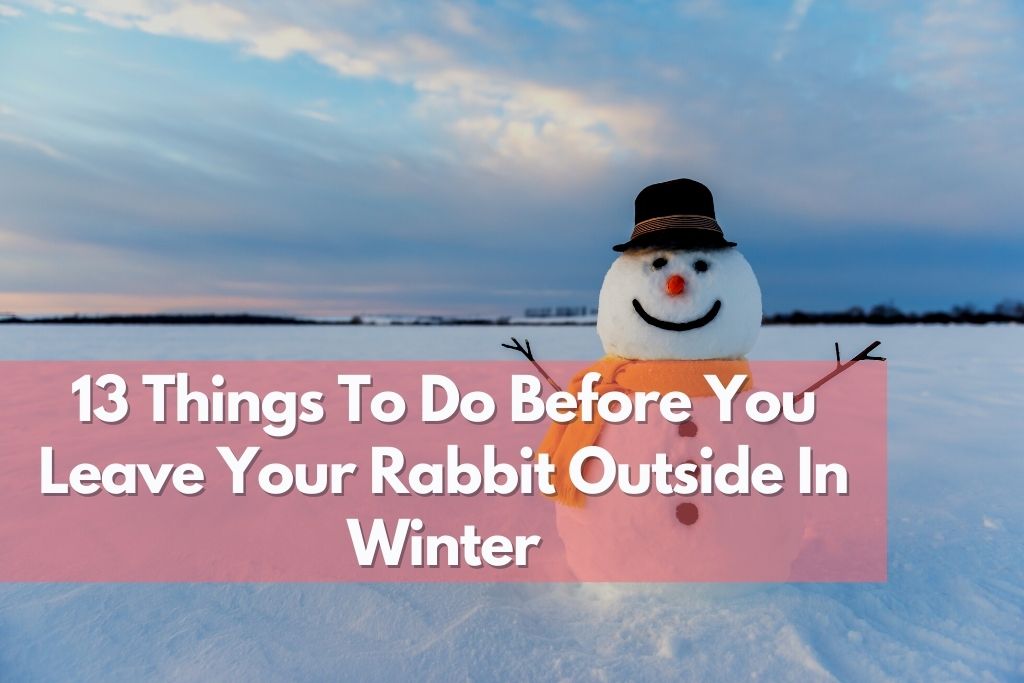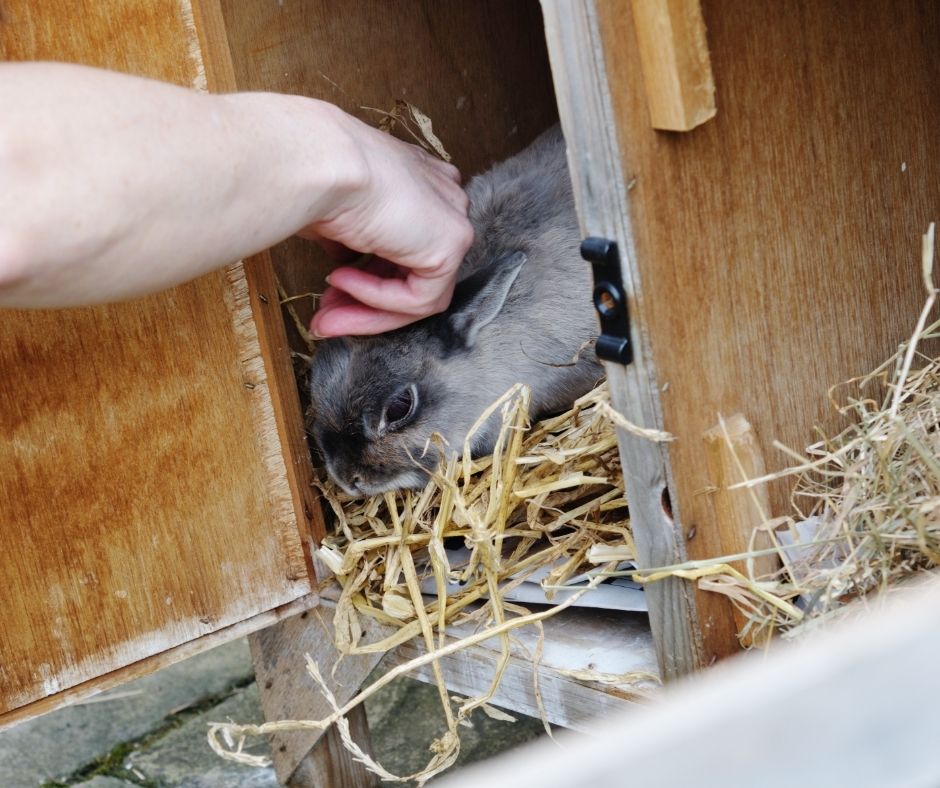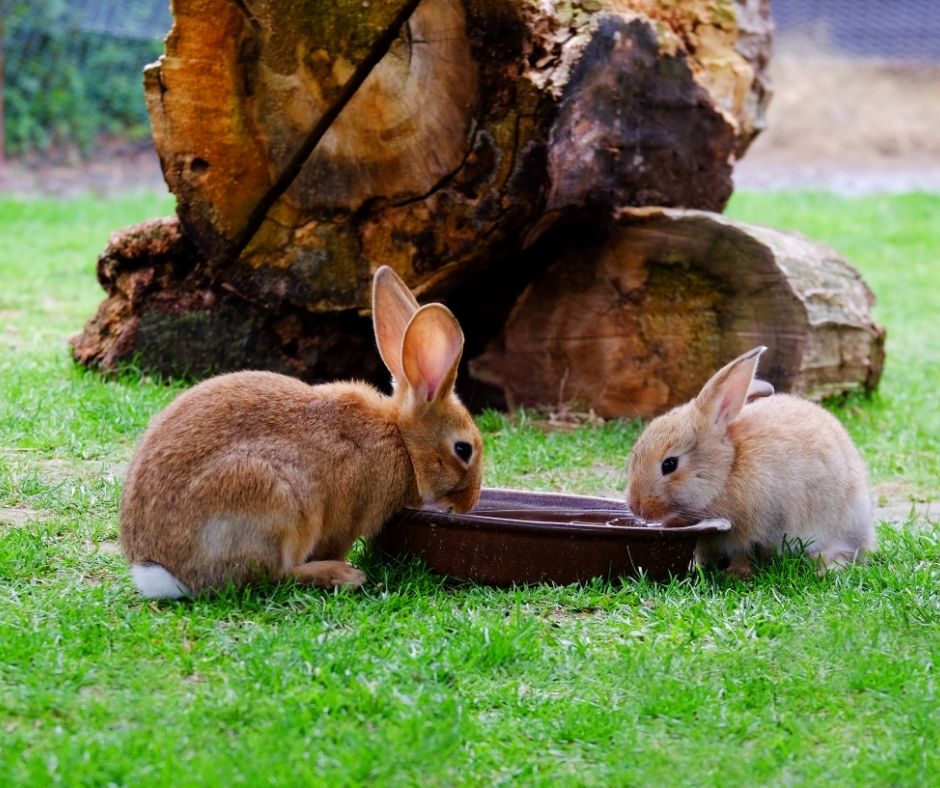Page Contents
Yes, rabbits are the animals with adaptations that make them capable of being able to live outside in winter, these include their soft fur coats and pads that provide enough warmth to them. However, this doesn’t mean you should stay assured that no matter how bad the weather gets, your bunny will stay outside happily.
Below are 13 important steps you should take for preparing your rabbits to stay outside in winters safely:

While they can survive moderate winters easily, you have to prepare them for the extreme chilly weather. In this article, we will tell you how you can prepare your rabbits to live outside in winters happily and healthily.
Accommodation For Rabbits To Live Outside In Winter
If your rabbits are familiar with be able to live outside in winter, it’s very important to prepare their hutch for winter. Generally, rabbits can do well in moderately cold winters as long as they have warm shelter to live.
In the case of wild rabbits, they live inside their underground warrens which offer enough warmth and safety to survive the freezing temperatures. But the pet rabbits live inside their hutches which rest above the ground, so you need to make sure that they are well insulated and don’t have any openings for chilled air to enter.
- Repair The Rabbits Hutch
If your rabbit’s hutch isn’t in a good condition, it will not provide any safety and protection for the rabbit to live outside in winter. So, before the cold weather arrives, perform necessary repairs and make sure it is water and moisture tight.
Start by looking at the insides of the hutch and see if there are any signs of dampness and water getting in. A damp surface indicates that water is entering from the surface of the ground to the hutch making it an uncomfortable shelter for the rabbits.
- Check And Repair/Replace The Roof
Next, check the roof of the hutch for any leaks or damages. If the damages are minor, you can use a sealant to make it leak proof. However, if the condition of the roof is very poor, consider replacing it. A majority of roofs are crafted using marine plywood which is covered with roofing felt.
If you’re replacing the roof, consider getting a sloped one instead of a flat roof. The slanted roofs don’t allow the water to sit and last for longer as well.
- Weather Proof The Walls
After making the necessary repairs to the roof, have a look at the sidewalls and consider weatherproofing them. Generally, the protective coating of the walls gets worn out over time. So, it should be reapplied every 2-3 years.
This not only prevents moisture and dampness from entering the rabbit hutch but also prevents the wood from rotting. A good idea is to paint the entire hutch with good quality, waterproof paint or varnish. It will not only give a new look but will also clean it.
After applying the paint, finish it off with a coat of wood preservative. However, make sure that the products you’re using are pet safe.
- Add Legs To Keep Dampness Away
Dampness is a major issue for the rabbit hutches. No matter how much you try to keep it dry and warm, it will get damp during heavy snowfall. So, the best idea to prevent this is adding legs to the hutch to provide some height to it.
While you can get hutches with inbuilt legs, if you don’t want to buy a new, raise it by putting bricks at four of the corners. It will offer a good height to your rabbit’s home and will eliminate the risk of flooding.
How To Keep The Rabbit Hutch Warm And Dry During Winters
We have already discussed how you can repair your pet’s hutch to make it a safe for your rabbits to live outside in winter. But this is not enough, there are some other things you should do to keep it warm and cozy for your furry friends.

- Reduce Drafts
Consider covering the large mesh doors partially using a plastic or Perspex. It will allow your pet to look out and soak in the sun and will also prevent it from rain and wind. You can also consider getting the panels for the greenhouse to keep the hutch warm.
However, make sure that there is enough ventilation. So, leave a few inches gap while covering the large mesh areas. Another smart idea is to turn the open face of the hutch towards a wall or some blocking object. This will prevent rain and wind from entering the hutch.
- Insulate the Hutch
You can also cover the hutch using a tarpaulin sheet or a blanket or even a thick bed sheet. This will offer to keep the hutch warm and will also prevent chilled wind from entering inside. However, make sure to keep a slight gap for ventilation otherwise the animals inside it might get suffocated.
Also, allow the sun to enter your rabbit’s home by lifting the side of blanket or tarpaulin and again cover it entirely during the nights. If you’re willing to spend a little, you can also buy some good quality hutch covers from the market.
You can easily get one below £20 / $25. Moreover, if you’re creative enough, you can sew a DIY hutch cover using old blanket or bedsheet!
- Move The Hutch
If you’re living in regions that suffer extreme winters and heavy snowfall, consider moving the rabbit hutch to an enclosed area such as a garage or shed. If you leave it outside, chances of your pets getting affected due to rigidity of whether will increase.
Also, if you’re keeping the hutch in the garage, make sure you don’t keep it near the place where you park your cars as the fumes are toxic for the little animals. Further, if your rabbits don’t live in a hutch but reside in a shed or playhouse, consider insulating it to provide enough warmth.
- Provide Thick Bedding
Rabbits will need a warm and cozy bed to live outside in winter. As compared to other seasons, you should provide a nice and thick layer of bedding in winters. Generally, most hutches have a separate bedroom area. If your hutch doesn’t have one or it is huge, consider getting a small box with a small entrance hole. The smaller area will stay warmer and allow your bunny to snuggle and have a happy sleep.
You can line the bedding using some newspapers at walls and the floor to keep the bedding dry and moisture-free. Another thing you should do is providing a good layer for littler on the surface and extra-thick bedding. During winters straw works better as compared to hay as it offers more warmth. So, replace hay with straw in winters. But provide enough hay for rabbits to nibble.
- Use A Heater
If your rabbits don’t live in a hutch but live under a shed, consider investing in a good greenhouse heater. It will help in maintaining the temperature and will prevent the animals from freezing.
Moreover, for hutches also you can buy heating pads or lamps. You can get plenty of such items below for a very affordable cost. Also, don’t place hot water bottles near the rabbits as they can chew them and they will also dampen the bedding by leaking.
- Replace The Rotten Wood
Most of the hutches are made of wood. Although wood is a great material, when it is exposed to fluids such as urine and water, it rots away. And when this happens, it starts harboring parasites and other harmful microorganisms which can cause various diseases in the pets living by.
Moreover, wet woods also dampen the surface and make the place wet, uncomfortable and cold.
Hence, it is very important to get rid of such wood.
- Daily Exercise
Exercising is the best way to keep our body warm during winters. This is true for rabbits as well. They need enough daily exercises to keep themselves warm. So, allow your pets to play and have daily runs. But again, keep the run warm by covering it partially.
A good idea is to connect your hutch with the run so that your bunny has a warm retreat when he arrives back at this shelter. Further, if your hutch is separate from the run, place a wooden box filled with straw or hay in the run. This will ensure that your rabbits have a good shelter when they’re done exercising.
For covering the run, you can use tarpaulin or plastic sheets. You can also use plywood panels for this purpose. Covering the run will also ensure that it is safe from the rain and snow.
- Provide Enough Food And Water
Rabbits who love outdoors require more food during winter months. Extra food provides them with energy and keeps them warm. A good idea is to check the weight of your pets and see if they are maintaining a healthy weight or not.
If they’re, then good otherwise take special care of their diets. Provide them with good quality rabbit pellets and enough fresh greens and vegetables.
- Prevent Water Bottles From Freezing
During extreme winters, water bowls get frozen during the night. You have to prevent it otherwise your pets will not have enough water to drink or might catch cold after drinking chilled water. A good idea is to insulate the bottle. It will prevent the bottles from freezing and will also keep the water at a good temperature.
If you don’t mind spending a little, you can buy insulated bottles from the market. Otherwise, you can also make a DIY bottle cover using a thick fabric. Some other cool ideas include wrapping the bottle with a sweater sleeve, old sock or bubble wrap.

Further, keep the bottle to a warm place. You can consider fixing it inside the hutch instead of mounting it outside the front mesh. These days, self-heating water bowls are becoming very popular among the pet owners.
They keep the water warm and prevent freezing of water during nights. While they are a bit expensive, you can consider getting one if your budget allows.
We also suggest using two water bottles/bowls if you can’t move them inside. You can use the spare bottle while the other one is getting defrost. It’s always nice to have backups in such conditions.
Related FAQs
Can Extreme Cold Kill A Rabbit?
Yes, external factors include extreme cold can kill your rabbit. While these animals can tolerate moderately cold temperatures with their fur coats and fur pads, they can’t stand extreme temperatures and could become sick or even die in worst cases.
What Temperature Is Too Cold For My Rabbit?
Generally, when a pet rabbit is kept dry and protected against chilly winds and moisture, it can easily survive the freezing temperatures. When the outside temperature falls below – 7 degree Celsius or 19 degrees Fahrenheit, it can be life-threatening for poor animal and this is when you should get concerned and consider getting your pets inside your home or garage.
Is It A Good Idea To Move Indoor Rabbits Outdoors In Winter?
If your rabbit is familiar with living indoors or it hasn’t been kept outdoors before, then it’s not at all a good idea to introduce it to the outside environment during winters. Your pet may not tolerate the extreme temperatures and could die due to it. So, if you want to move your rabbits outdoors, wait till the winter is gone.
Can I Put A Sweater On My Rabbit?
If your bunny doesn’t mind being handled by you and if the temperatures have dropped down to an extreme point, you can dress up your pet using a soft and warm sweater with perfect fitting. However, if your rabbit doesn’t like to be handled, avoid stressing him by putting unnecessary clothes on him.
Also, make sure your furry friend is happy after wearing a sweater. If he’s not, consider taking it off and leaving him as he likes.
That’s all for now. We hope our guide helps you in taking care of your bunny in winters.